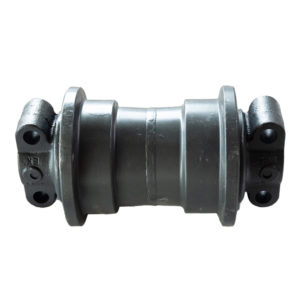Diagnosing and troubleshooting issues with mini excavator track rollers is essential to ensure the machine’s smooth operation and prevent further damage.
Here’s a step-by-step guide on how to go about it:
- Visual Inspection:
- Start by performing a thorough visual inspection of the track rollers and their surrounding components.
- Look for any signs of damage, wear, or irregularities in the rollers, such as cracks, missing pieces, or loose bolts.
- Listen for Unusual Noises:
- When the mini excavator is in operation, pay close attention to any unusual noises coming from the track rollers.
- Unusual noises can indicate issues like loose or damaged components.
- Check for Uneven Wear:
- Examine the condition of the rubber tracks and inspect for uneven wear patterns.
- Uneven wear may be a sign of misalignment or damaged rollers.
- Check for Loose Bolts and Fasteners:
- Inspect the bolts and fasteners that secure the track rollers to the undercarriage.
- Ensure that they are properly tightened and not missing.
- Test for Track Alignment:
- Check if the tracks are properly aligned with the rollers.
- Misalignment can cause excessive wear and affect the machine’s stability.
- Measure Roller Play:
- Gently push and pull the track rollers to check for any excessive play or movement.
- Excessive play can indicate worn bearings or bushings.
- Inspect Seals and Lubrication:
- Examine the seals around the track rollers for damage or leaks.
- Ensure that the rollers are adequately lubricated to reduce friction and wear.
- Monitor Track Tension:
- Verify that the track tension is within the manufacturer’s recommended specifications.
- Overly tight or loose tracks can lead to roller issues.
- Review Operating Conditions:
- Consider the operating conditions of the mini excavator, such as the type of terrain it has been used on.
- Certain terrains or heavy use can accelerate wear and tear on the track rollers.
- Consult the Owner’s Manual:
- Refer to the mini excavator’s owner’s manual for maintenance guidelines and troubleshooting tips specific to your machine.
- Seek Professional Help:
- If you identify any issues that you cannot address yourself or if the problems are severe, it’s advisable to contact a qualified technician or the equipment manufacturer for further inspection and repair.
Remember that regular maintenance and timely troubleshooting can help extend the lifespan of your mini excavator’s track rollers and ensure safe and efficient operation.
What is the typical lifespan of mini excavator track rollers, and when should they be replaced?
The typical lifespan of mini excavator track rollers can vary based on several factors, including the quality of the rollers, the operating conditions, and the maintenance practices. Generally, you can expect the following guidelines:
- High-Quality Rollers: Mini excavator track rollers made from high-quality materials and proper manufacturing processes tend to have a longer lifespan. They can last anywhere from 1,000 to 2,000 hours or more of operation.
- Operating Conditions: The type of terrain and usage conditions can significantly affect the lifespan of track rollers. Rough and abrasive terrains, as well as heavy loads, can accelerate wear and reduce the lifespan.
- Maintenance: Regular maintenance and proper care of the track rollers are crucial for extending their lifespan. This includes lubrication, track tension adjustment, and routine inspections.
- Inspection: Track rollers should be inspected regularly for signs of wear, damage, or misalignment. Any visible damage or irregularities should be addressed promptly.
- Replacement Indicators: There are several signs that may indicate it’s time to replace mini excavator track rollers:
- Excessive wear: If the rollers are visibly worn down or have flat spots.
- Severe damage: Cracks, breaks, or missing components in the rollers.
- Increased noise: Unusual or loud noises coming from the rollers during operation.
- Misalignment issues: If the rollers cause the tracks to deviate or become misaligned.
- Frequent breakdowns: If the rollers require frequent repairs, it may be more cost-effective to replace them.
- Manufacturer Recommendations: Refer to the manufacturer’s guidelines for specific recommendations on the replacement intervals and conditions for your mini excavator’s track rollers.
It’s essential to address track roller issues promptly to prevent further damage to your mini excavator and to ensure safe and efficient operation. Regular maintenance and inspections can help you identify problems early and extend the lifespan of the track rollers. When replacement is necessary, use high-quality replacement parts and follow the manufacturer’s recommendations for installation.
